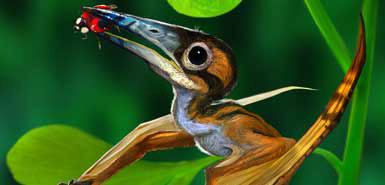Rare Fossil Find – A Tiny Pterosaur from the Ancient Cretaceous Forests of China
“Flapping about quite at home in its arboreal environment, jumping between bennettitales, cycads and conifers a tiny pterosaur flies upwards and perches safely on the uppermost branches of a ginkgo whilst a dinosaur rumbles by far below.”
Until now scientists, could only speculate as to what sort of pterosaurs lived in forest and jungle environments. These habitats do not lend themselves easily to fossil preservation and palaeontologists have had to content themselves with the occasional find that provides a glimpse into the dark forest environments of the Mesozoic. In addition, the light and delicate bones of pterosaurs could easily be damaged and crushed well before burial and fossilisation could take place, so scientists have had to content themselves with a few rare finds from inland ecosystems, concentrating their pterosaur research on those specimens preserved in marine sediments, where generally the chances of fossilisation are higher. Also, marine environments being relatively open would permit larger organisms and their relatively larger bones would perhaps have a greater chance of surviving the fossilisation process.
However, thanks to an amazing discovery by a joint Brazilian and Chinese team, scientists have the chance to study the fossils of a tiny, forest pterosaur from the Lower to Middle Cretaceous. Discovered in western Liaoning the remains of the smallest pterosaur species on record reveal that there were flying reptiles with wingspans no bigger than a garden robin’s sharing the forests with dinosaurs. Although some of the later pterosaurs evolved into huge animals – Pteranodon and Quetzalcoatlus for example, scientists had speculated that there were many thousands of other species of smaller pterosaurs that filled other ecological niches.
Tiny Pterosaur
This new species, is thought to be the smallest pterosaur yet found. Only one smaller pterosaur has been found and that was a juvenile that had only just hatched. The animal has been named Nemicolopterus crypticus, the fossil shows a number of adaptations for a life amongst the trees. For example, the eye sockets are quite large, indicating that this pterosaur could have coped well with low light levels in the understorey of a dense primeval forest. The four-toed hind feet had sharp claws, which could possibly have been able to grasp branches, giving this tiny flying reptile a good purchase amongst the tree tops.
Artists Impression of Nemicolopterus crypticus

Picture Credit: Lewis Smith
“Nemicolopterus crypticus presents the best adaptations for an arboreal lifestyle found in any pterosaur,” the research team from China and Brazil reported.
Interestingly, all the illustrations of this new discovery show this tiny flying reptile predating on insects. There would have been abundant insects within the forest environment for this little creature to hunt. However, the remains of the jaws show that this little pterosaur, had no teeth, just like his larger and more illustrious relatives such as Pteranodon. If it was warm-blooded then insects would have provided a high energy diet to keep the animal active, but it may also be worth considering whether this little chap had another food source, one that would have been virtually exclusive to it – nectar, flowers and fruit
PNSO Nemicolopterus
PNSO have made a range of small, prehistoric animal models including a replica of the pterosaur Nemicolopterus: PNSO Age of Dinosaurs.
Scientists speculate that at around this time the first flowering plants (Angiosperms) were beginning to evolve. Small pterosaurs could have supplemented their insect diets with flowers, nectar and fruit (all high energy food stuffs). Perhaps little Nemicolopterus specialised in eating these relatively new plants, the toothless beak could have been ideal for exploiting this new food source. Unfortunately, the very tip of the beak has been lost in fossilisation so scientists are unsure how the end of the beak looked. This could have yielded vital clues as the eating preference’s of this tiny flier. To balance the argument it is worth pointing out that many species of birds thrive on insects and arthropods today and they do not have any teeth in their beaks to help them catch these animals (an adaptation long after the days of Archaeopteryx to help Aves lighten themselves to aid powered flight).
Certainly, there must have been many different types of pterosaur exploiting arboreal niches, the low likelihood of preservation has prevented palaeontologists from studying this particular branch (no pun intended); of the pterosaur family tree. The birds were evolving and by the end of the Cretaceous only the very large Azhdarchidae type pterosaurs remained. Perhaps birds out competed pterosaurs for certain ecological niches and this hastened the demise of the pterosaurs.
To read more about whether birds led to the extinction of flying reptiles: Did the birds wipe out the Pterosaurs?
Within the sediments of Liaoning, there may be other fossils waiting to be discovered that can shed more light on the lives of the forest dwelling pterosaurs.






Fascinating stuff! This and yesterday's entry are the reason I keep coming back to this blog day after day.